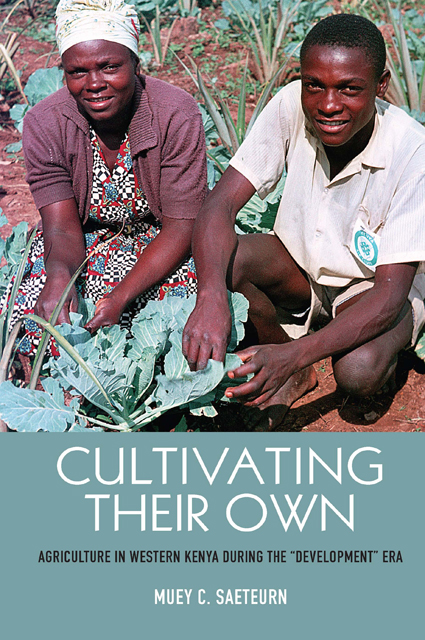Book contents
- Frontmatter
- Dedication
- Contents
- Acknowledgments
- Acronyms and Abbreviations
- Maps
- Introduction
- 1 The Role of Agriculture in Kenya’s Political Economy in the Era of Transition and Independence
- 2 Western Kenya’s Region, People, and the Origins of Population Density
- 3 Chavakali Secondary School: A Place of Learning and Farming
- 4 “Doing Their Part”: 4-K Farmers’ Clubs
- 5 Friends and Acres: The Friends Africa Mission Stewardship Program
- 6 “Home is Home”: The Lugari Settlement Scheme and Maragoliland
- Conclusion: Agricultural Production—The New (Old) Sexy
- Appendix: Interviewee Information
- Notes
- Bibliography
- Index
- Frontmatter
- Dedication
- Contents
- Acknowledgments
- Acronyms and Abbreviations
- Maps
- Introduction
- 1 The Role of Agriculture in Kenya’s Political Economy in the Era of Transition and Independence
- 2 Western Kenya’s Region, People, and the Origins of Population Density
- 3 Chavakali Secondary School: A Place of Learning and Farming
- 4 “Doing Their Part”: 4-K Farmers’ Clubs
- 5 Friends and Acres: The Friends Africa Mission Stewardship Program
- 6 “Home is Home”: The Lugari Settlement Scheme and Maragoliland
- Conclusion: Agricultural Production—The New (Old) Sexy
- Appendix: Interviewee Information
- Notes
- Bibliography
- Index
Summary
In a televised speech given on September 11, 1964, Jomo Kenyatta, then the Prime Minister of Kenya, emphasized to his fellow Kenyans that the greatest asset they possessed as citizens of a newly-independent nation-state was the land. “In land lies our salvation and survival,” he stated, “whatever our plans for the future, they must spring from a resolve to put to maximum production our land, however small the acreage we possess.” Having only assumed complete sovereignty from Britain on December 12, 1963, Kenyatta and his Kenya African National Union (KANU) government were hard at work building the new nation-state. Though KANU politicians disagreed as much among themselves as with members from the oppositional Kenya African Democratic Union (KADU) party about what type of Kenyan state would be built, they recognized the urgency of addressing the socioeconomic issues persisting from the colonial era. Specifically, the uhuru (independence) government focused on reducing the high unemployment rate, especially in urban centers, along with alleviating the acute landlessness and land-shortage problems their constituents faced and expected them to fix.
With these objectives in mind, Kenyatta initiated the “Back to the Land” movement and put into motion the KANU government’s ambitious project of pragmatic agrarianism. This project was a series of development policies and schemes intended to increase the nation’s commercial agricultural output by making full-time farming popular with the wananchi (citizens). Government-sponsored agrarianism aimed to produce rapid economic development for poor Kenyans by bringing them into the market economy as either productive smallholder cash crop farmers or skilled agricultural laborers working on the plantation estates owned by foreigners and wealthy political elites.
For the Kenyatta regime and its development partners such as the World Bank and missionary societies like the Friends Africa Mission (FAM), the agrarianism project made sense because Kenya was predominately an agricultural country with no way of growing the economy other than through its export farming. Having the Kenyan citizenry maintain the productivity of commercial farms located mainly in Kenya’s former “white highlands,” an area located in the present-day Rift Valley and Central Province that held the country’s most fertile and arable lands that European settler-farmers dominated until independence, was fundamental to the KANU government’s nation-building program.
- Type
- Chapter
- Information
- Cultivating their OwnAgriculture in Western Kenya during the 'Development' Era, pp. 1 - 25Publisher: Boydell & BrewerPrint publication year: 2020



